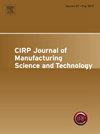评估边界条件和夹紧力对混合堆垛机器人抢先钻进的影响
IF 5.4
2区 工程技术
Q2 ENGINEERING, MANUFACTURING
CIRP Journal of Manufacturing Science and Technology
Pub Date : 2025-04-16
DOI:10.1016/j.cirpj.2025.04.003
引用次数: 0
摘要
空中交通的快速增长以及对更可持续解决方案的日益关注要求提高燃油效率和降低成本,这突出了轻型材料在飞机制造中的重要性。本研究研究了碳纤维增强聚合物与AA7075-T6叠层的一次性钻孔工艺,重点研究了工艺参数、钻孔边界条件和夹紧力对孔质量的影响。利用机器人钻井系统对理想和非理想边界条件进行了研究。在理想边界条件下,确定了最佳钻孔参数:CFRP的切削速度为85 m/min,进给量为0.01 mm/rev; AA7075-T6的切削速度为60 m/min,进给量为0.05 mm/rev。因此,采用参数切换策略改善材料过渡区孔质量。然后,在非理想边界条件下,机器人末端执行器施加不同的夹紧力(0 N、250 N和400 N),结果表明,较高的夹紧力可显著减少层间间隙,导致进入毛刺减少60.27%,分层系数降低16.10%。这种全面的方法可以更深入地了解工艺参数和边界条件如何影响孔质量和工具力,为优化航空航天制造中的钻井工艺提供新的见解。本文章由计算机程序翻译,如有差异,请以英文原文为准。
Evaluating the impact of boundary conditions and clamping force in robotic one-up drilling of hybrid stacks
The rapid increase in air traffic and the growing focus on more sustainable solutions require improvements in fuel efficiency and cost reduction, highlighting the importance of lightweight materials in aircraft manufacturing. This study investigates the one-up drilling process of Carbon Fibre Reinforced Polymer and AA7075-T6 stack, focusing on the influence of process parameters, drilling boundary conditions and clamping force on the hole quality. A robotic drilling system was used to study both ideal and non-ideal boundary conditions. Under ideal boundary conditions, optimal drilling parameters were identified: a cutting speed of 85 m/min and a feed rate of 0.01 mm/rev for CFRP, and 60 m/min with 0.05 mm/rev for AA7075-T6. Therefore, parameter switching strategies were implemented to improve hole quality at the material transition zone. Then, under non-ideal boundary condition, variable clamping forces (0 N, 250 N, and 400 N) were applied by the robot's end effector, demonstrating that higher clamping forces significantly reduce interlayer gaps, leading to up to 60.27 % reduction in entry burr and 16.10 % decrease in delamination factor. This comprehensive approach provides deeper understanding on how process parameters and boundary conditions affect both hole quality and tool forces, offering new insights for optimising drilling processes in aerospace manufacturing.
求助全文
通过发布文献求助,成功后即可免费获取论文全文。
去求助
来源期刊

CIRP Journal of Manufacturing Science and Technology
Engineering-Industrial and Manufacturing Engineering
CiteScore
9.10
自引率
6.20%
发文量
166
审稿时长
63 days
期刊介绍:
The CIRP Journal of Manufacturing Science and Technology (CIRP-JMST) publishes fundamental papers on manufacturing processes, production equipment and automation, product design, manufacturing systems and production organisations up to the level of the production networks, including all the related technical, human and economic factors. Preference is given to contributions describing research results whose feasibility has been demonstrated either in a laboratory or in the industrial praxis. Case studies and review papers on specific issues in manufacturing science and technology are equally encouraged.
 求助内容:
求助内容: 应助结果提醒方式:
应助结果提醒方式:


